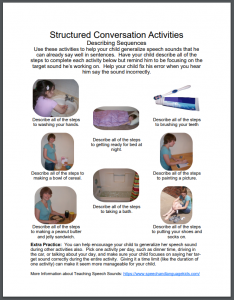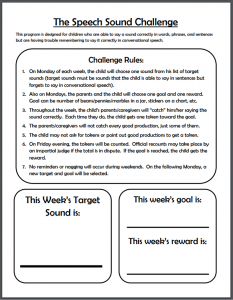Traditional Van Riper Articulation Approach
Description:
Task Analysis (How To):
- Sound in Isolation: Student will produce the target sound in isolation (by itself, not in a word or with other sounds)
- Sound in Syllables: Student will produce the target sound in non-sense syllables
- Sound in Words: Student will produce the target sound in all positions of single words (beginning of the word, middle of the word, and end of the word)
- Sound in Phrases: Student will produce the target sound in all word positions of 2-3 word phrases
- Sound in Sentences: Student will produce the target sound in all word positions of simple sentences
- Sound in Structured Conversation: Student will produce the target sound in all word positions of structured conversational tasks, such as answering an open-ended question or describing a short sequence of events
- Sound in Unstructured Conversation: Student will produce the target sound in all word positions of unstructured conversation throughout multiple enviornments
Activities:
Here are some resources for helping your clients produce the target sound in isolation.
Tips for Eliciting Speech Sounds in Isolation
Click Here to Watch the Webinar Recording on Speech Sounds in Isolation
Speech Sound Warm-Up:
Works on sound stimulability! Work on the sounds in isolation or write a vowel in the middle and have the child pair the consonants with the vowel.
Try these great resources for helping your clients pair the target sound with vowels to make nonsense syllables.
Sound Syllable Spiders
These cute little spiders will help your clients practice pairing consonants with different vowels
Now it’s time to put those sounds into words! Check out these resources to help you do just that:
Articulation Worksheets:
One for every sound! Single words that contain the sound in all word positions. Use these in therapy or send them home for homework!
Now we’re start putting those words into short 2-3 word phrases. These resources should help with that:
Phrase Generator for Speech Therapy
This quick cheat sheet will give your clients some predictable phrases to insert their words into.
Articulation Worksheets:
One for every sound! Single words that contain the sound in all word positions. Use these in therapy or send them home for homework!
Is your client ready for sentences? Time to use those words to build sentences. I like to have my students try to come up with the sentences themselves. Bonus points if they can get two words with their target sound into one sentence!
Articulation Worksheets:
One for every sound! Single words that contain the sound in all word positions. Use these in therapy or send them home for homework!
Ok! Your client is able to use the target sound in sentences, great!! Unfortunately, that doesn’t necessarily mean that he will automatically be ready for saying it correctly all of the time in conversation! Let’s try some of these simple structured conversation prompts to practice the sound in a more complex environment:
Sounds in Structured Conversation Pack
Reading Activities:
This is also a great time to have your client practice the new skill during reading activities. Here are a few resources to help you with that:
Now comes the hard part, getting them to do it the rest of the time!
Click Here to Watch the Carry-Over Webinar Recording
Tips for Encouraging Speech Sounds in Conversation
Speech Sound Carry-Over Challenge
Troubleshooting:
What do you do if these things don’t work the way they’re supposed to? Well, nothing’s ever easy, is it? Try these great troubleshooting tips that some of our other members have found helpful. Click the problem to drop down the link to the solution.






















